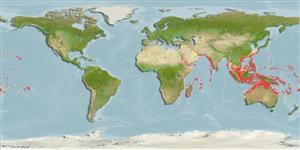Environment: milieu / climate zone / intervalo de profundidade / distribution range
Ecologia
marinhas associadas(os) a recifes; não migratória; intervalo de profundidade 1 - 100 m (Ref. 48391). Tropical; 31°N - 28°S, 32°E - 144°W
Indo-Pacific: Red Sea and East Africa to Line and Tuamoto islands, North to southern Japan and the Ogasawara Islands, South to the Great Barrier Reef, New Caledonia, and the Austral Islands (Ref. 33390). Mention from Hawaii Is., but likely to be aquarium releases (Ref. 58302). Not found in Easter Island, Rapa and the Marquesan Islands (Ref. 48391).
Length at first maturity / Tamanho / Peso / Idade
Maturidade: Lm 25.0 range ? - ? cm
Max length : 40.0 cm SL macho/indeterminado; (Ref. 30573); Idade máx. registada: 14 anos (Ref. 72479)
Espinhos dorsais (total) : 13 - 14; Raios dorsais moles (total) : 17 - 21; Espinhos anais: 3; Raios anais moles: 18 - 21.
Body shape (shape guide): short and / or deep; Cross section: compressed.
Juveniles are encountered under ledges, or in holes of outer lagoon patch reefs or semi-protected areas of exposed channels and outer reef flats. Subadults move to reef front holes and surge channels. Large adults inhabit ledges and caves in areas of rich coral growth on clear lagoon, channel, or seaward reefs (Ref. 6113). Benthopelagic (Ref. 58302). Feed on sponges and other encrusting organisms (Ref. 6113); also on tunicates. Form pairs. Young and adults may clean much larger fishes such as sunfish (Ref. 48636). Frequently exported through the aquarium trade. Juveniles are distinguished by a white dorsal-fin margin (Ref. 48391).
Myers, R.F., 1991. Micronesian reef fishes. Second Ed. Coral Graphics, Barrigada, Guam. 298 p. (Ref. 1602)
Categoria na Lista Vermelha da IUCN (Ref. 130435: Version 2025-1)
Ameaça para o homem
Harmless
Utilização humana
Pescarias: pouco comercial; Aquário: Espécies comerciais
Ferramentas
Relatórios especiais
Descarregue XML
Fontes da internet
Estimates based on models
Preferred temperature (Ref.
123201): 24.6 - 29, mean 27.9 °C (based on 1496 cells).
Phylogenetic diversity index (Ref.
82804): PD
50 = 0.5001 [Uniqueness, from 0.5 = low to 2.0 = high].
Bayesian length-weight: a=0.02512 (0.01462 - 0.04317), b=2.87 (2.73 - 3.01), in cm total length, based on LWR estimates for this species & Genus-body shape (Ref.
93245).
Nível Trófico (Ref.
69278): 2.9 ±0.05 se; based on food items.
Generation time: 16.4 ( na - na) years. Estimated as median ln(3)/K based on 1
growth studies.
Resiliência (Ref.
120179): Baixo, tempo mínimo de duplicação da população 4,5 - 14 anos (K=0.06; Fec > 10,000;).
Fishing Vulnerability (Ref.
59153): High to very high vulnerability (68 of 100).
🛈
Nutrients (Ref.
124155): Calcium = 36.1 [16.0, 61.1] mg/100g; Iron = 0.475 [0.267, 0.836] mg/100g; Protein = 18 [17, 19] %; Omega3 = 0.0941 [, ] g/100g; Selenium = 39.9 [18.9, 92.0] μg/100g; VitaminA = 68 [14, 303] μg/100g; Zinc = 1.4 [0.9, 2.1] mg/100g (wet weight);
